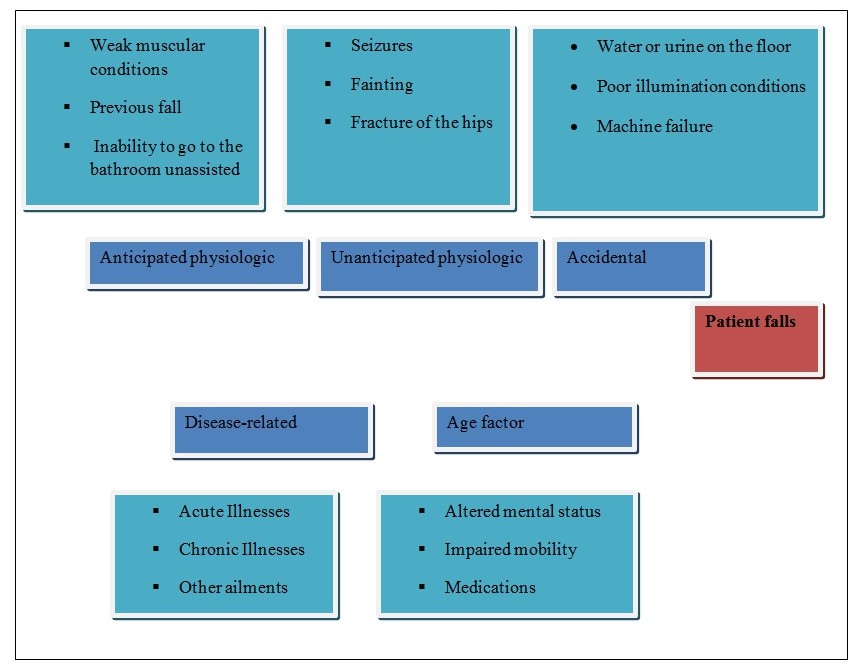Health professionals have continuously used a multiplicity of analytical tools to assist them to understand the causes of particular health conditions in the context of why and how such health risks arise. One such tool is called the Root Cause Analysis (RCA), which is principally used to address a particular problem with the aim to get to the “root cause” of why and how such problem exists. In other words, the RCA is used to correct or eradicate the causes with a view to preventing a particular problem from ever happening again (Root Cause Analysis, n.d.). This paper purposes to use a Fishbone (RCA) diagram to identify five major categories of contributing causes and three reasons under each category as causes for patient falls.
A fishbone diagram will inarguably assist health practitioners to brainstorm possible causes of patient falls and undertake further analysis to synthesize factors that may be contributing either directly or indirectly to the problem of patient falls. Based on the stated objective of this particular paper, the fishbone diagram would appear as follows (see next page):
In analyzing the fishbone diagram, it is important to underline that about 14% of all falls in hospital settings are accidental, another 8% occurs as a result of unanticipated physiologic causes, while 78% are occasioned by anticipated physiologic causes (Morse, 2009). These orientations form the major categories of patient falls in hospital settings. However, Morse (2009) notes that the age factor should be included as an independent category, principally because the majority of the patients who fall consist of the elderly. As such, it is imperative to evaluate the core age-related causes related to patient falls in the hospital. Still, the Joint Commission Resources (2007) is of the opinion that disease-related causes of patient falls should be separated from the other categories to facilitate proper management of the condition. Some of the diseases that have been noted to contribute to patient fall in hospital settings include arthritis, heart disease, and kidney disease.

The RCA analysis depicted in the Fishbone diagram above shows that it is possible for health professionals to zero in on the core causes of patient falls by using known categories of such causes. Current literature demonstrates that accidental causes of patient falls are mainly caused by environmental factors, while anticipated physiologic causes are mainly triggered by unpredictable factors of the physiologic origin and unanticipated causes triggered by biological conditions that are not in any way related to an external factor (Morse, 2009). The age factor is critical in any analysis concerning patient falls since it is the elderly who bears the brunt of the condition (Joint commission resources, 2007).
Of importance in this analysis, however, is the fact that the elimination of the core causes of patient falls in each of the categories will ultimately lead to the elimination of the problem of patient falls within the hospital settings. However, this can only be achieved in theory but not in practice since, as has been demonstrated in the Fishbone diagram, some causes such as those in the unanticipated physiologic category and the age category are hard to control. The task therefore should be for health practitioners to identify categories of causes and core causes that are easy to control (such as accidental and anticipated causes) in an attempt to minimize the incidences of patient falls in hospital settings (Morse, 2009; Joint Commission Resources, 2007). All in all, it is important to note that preventing falls among patients in hospital settings necessitates a multifaceted paradigm, and the recognition and evaluation of core causes of patient falls is of immense importance in the provision of effective remedies to the condition. The Fishbone diagram on the previous page correctly shows that RCA can be effectively used to identify and evaluate these causes.
Reference List
Bartley, J. (2004). Preventing patient falls. Web.
Joint Commission Resources. (2007). Good practices in preventing patient falls. A collection of cases. Joint Commission Resources
Morse, J.M. (2009). Preventing patient falls: Establishing a fall intervention program, 2nd Ed. New York, NY: Springer Publishing Company, LLC
Root Cause Analysis. (n.d.). 2011. Web.